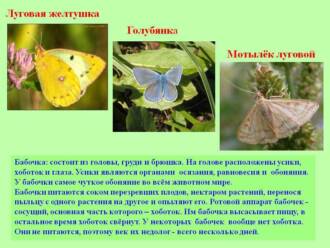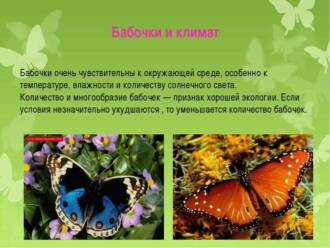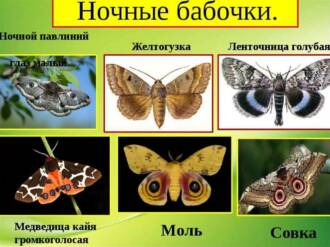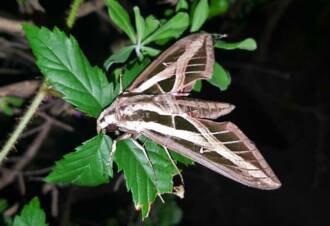The night butterfly is an insect belonging to a species characterized by a richness of species diversity. They differ in that they lead an active life mainly at night or at dusk. These insects differ from diurnal ones in structure, having a longer body, and in color - which is not as bright and colorful as those of lovers of sunlight.

Appearance and structure of butterflies
Butterflies are called different whiskers, which is associated with the anatomical structure of the antennae, which look like feathers or threads.
What does a night butterfly look like? Her body, like other species of this order of insects, has three sections, the abdomen, sternum and head. The latter in butterflies does not differ in size, it is decorated with eyes and large antennae. There are 2 pairs of wings on the chest of the insect, and its body is covered with tiny scales and hairs.
The oral apparatus has some features:
- the proboscis, with which the insect takes food, is presented in the form of a flat spiral, which folds and unfolds and opens directly into the larynx;
- when the proboscis is not needed, it is twisted and hidden under the scales that cover the butterfly's head;
- when unfolded, the proboscis is ideally suited for absorbing liquids;
- adults have jaws (similar to those found in caterpillars and other insect species) that allow them to chew on the necessary objects.
As for the wings, they practically do not differ from those of diurnal individuals. Nocturnal beauties have 2 pairs of wings, which are quite densely dotted with tiny hairs, as well as scales that form clusters of hairs.
The structure of the wings may differ in different subspecies:
- a butterfly may not have wings at all (such structure transmitted by insects from generation to generation and is an evolutionary manifestation);
- have a wide surface of the wings;
- have very narrow wings, almost linear.
The flight that a butterfly can demonstrate also depends on the structure of the wings. For example, the males of the wolverine are excellent flyers that dive magnificently in the night sky. And their females can be both with wings and without them.
On the other side, species of moths are known that have wings of a standard size and shape that do not allow the insect to fly (for example, in the silkworm). The aircraft is best developed in a night butterfly - hawk hawk subspecies, whose narrow wings have a high frequency of flapping, allowing them to fly quickly and hover in the air for a while, as hummingbirds do.
In some subspecies of moths (the same hawk moth, glass case), there are no scales and hairs on the surface of the wings. However, this fact does not affect their ability to fly in any way, the narrowness of the wings allows them to stay stably in the air.
Small individuals have rather narrow wings that keep them in the air only due to thick scales located on the sides.
The main difference between diurnal and nocturnal butterflies is the mechanism for attaching the rear and front pairs of wings:
- bridle: in this case, a small process departs from the hind wings, which is inserted into the segment of the fore wing. In males, it is located on the lower part of the forewing, in females - on the basis of the medial vein, it is a cluster of villi.
- Yugum: on the front wing there is a small blade, which is fixed at its base. It is she who fastens both wings with each other.

The sense organs of butterflies are presented as follows:
- Olfactory organs: in a moth, they are outgrowths that have the shape of a cone or wedge. Around them are a number of sensory cells that lie in the deep layers of the skin and connect with the nerves responsible for sensory functions. The scent of butterflies is quite sharp, it is thanks to him that they find males, females or food.
- hearing organs: some individuals are distinguished by the presence of tympanal organs, which are absent in diurnal moths. Receptors of this type are located on the abdomen or the back of the sternum, in special lateral recesses, which are covered with a cuticular membrane (there is a trachea under them). Sound waves that travel through the air cause the membrane to vibrate, which excites the cells and transmits information through the sensors.
- organs of vision: moths have two faceted eyes that occupy the main surface of the head. These organs of vision have the same structure as those of other insects: they consist of many tiny elements, including the lens, retina and innervation. As a rule, night butterflies see much better near than far away. The organs of vision of moths are intended, first of all, in order to fix the oncoming movement and to move in space themselves.
The eyes of butterflies are arranged in such a way that they perceive all information separately. Therefore, the insect receives a mosaic image at the output, which magnifies the real image of the object several times.

Color features
Seeing the flowering of these insects, many are wondering if night butterflies are dangerous. In fact, they are no more dangerous than diurnal varieties, but the pigmentation of moths deserves attention.
The color of butterfly wings has a dual nature: structural and pigmented.. This means that in the scales, which are located on the surface of the body of insects, there is a pigment. It is he who absorbs the sun's rays or just daylight, reflects them, due to which the solar spectrum of shades appears, visible to the human eye. As for the structural part of the color, it appears as a result of the refraction of the rays of the sun, which does not require the presence of pigment.
Important! Night butterflies have a predominantly pigmented type of color.

Ways to protect yourself from enemies
Night butterflies of Russia, and all others, are created by nature in such a way as to be protected from ill-wishers.
The list of defense mechanisms of moths is presented below.
Building shelters: different subspecies of moths organize similar protective structures for themselves. For example, cases and bags. The caterpillars of these moths, some time after they hatch, build houses, around which pieces of foliage and various debris are fixed.
These shelters are designed in a special way so that the larva protrudes from them just enough so that it can quickly hide inside in case of danger.. The house grows with its mistress, at least until she grows up and becomes a chrysalis (this size is approximately 4-5 cm). After the allotted time, the butterflies come out, but only if we are talking about males. Females stay in these houses longer, until they are fertilized by the male and lay their eggs.
Protective structures of the body, including hairs and glands, are also moth defenses. Do moths bite with such a formidable weapon? The answer is obvious: only if necessary.
Many caterpillars have a series of bristles or hairs that can burn with poison hidden in the skin glands. During an attack, a dangerous mixture is sprayed from the tip of the bristles, which irritates the enemy's skin.
In addition, insects use the following means of protection:
- glands in larvae, with the help of which they cover their own body with a liquid that repels approaching predators;
- individual individuals begin to actively move during the approach of the enemy or pretend to be dead, or curl up into a tight ball;
- larvae, at the moment of approaching danger, can fall from the branches on which they live, hanging on thin silk threads (the individual returns back along the same thread, slowly moving along it with its legs located on the chest and oral appendages);
- hawks have dorsal growths that look like horns, which they direct towards the approaching danger;
- insects can defend themselves by covering them body spiny long hairs.
Butterfly pupae, so helpless in appearance, also have defense mechanisms against a sudden enemy attack:
- pupae living in the soil are colored in tones that make them invisible;
- moths weave silk cocoons (in the silkworm, such shelters can have up to three layers - loose, dense and membranous), in which they hide from predators.
Coloration for protection from predators
Protective pigmentation moths have two types of colors:
- Patronizing (cryptic) - helps butterflies blend in with the surrounding space. For example, a moth can completely merge with needles on a spruce or foliage on a tree. Other subspecies may have the appearance of tree knots, freeze on a branch at the moment of danger, pretending to be the smallest branches (this is what moths and tapeworms do).
- Warning (frightening) - in itself attracts the attention of predators, but draws their attention to the fact that the individual has protective means in its arsenal (unpleasant taste, caustic secretion of the glands, the presence of burning hairs on the surface).
The ability of moths to disguise themselves when danger occurs is admirable. Some merge with granite rocks, others take on the appearance of bird droppings, others - bark, flowers or foliage.
Ribbons differ in coloration, which is visible at the time of flight, on the open hind wings. However, this species is completely invisible at rest, if the butterfly folds its wings, the pattern on its back resembles foliage or tree bark.
The wings of night beauties are often decorated with a pattern in the form of wide-open eyes. This allows you to keep predators at a distance.

industrial melanism
Industrial melanism is the presence of a pigment in the body of moths that makes them darker than other individuals. This ability is inherited.
Currently, there is an upward trend in the melanized species, especially for populations living in Europe. If earlier the light color of the night butterfly was the species norm, today dark moths are replacing them. Although light moths have a higher survival rate in nature, dark moths are better adapted to life with a lack of nutrients. However, constant encounters with predators leave melanists in the minority.
In areas with industrial production, where many objects of the plant world are covered with soot, melanistic butterflies survive better than their white counterparts, because their camouflage abilities are higher.. In addition, they feed on food that is contaminated with industrial waste and this does not affect their life in any way, unlike light moths.
Life cycle
How long do night butterflies live? The life cycle of these insects deserves close study, it can be divided into several successive stages:
- Eggs are laid by these moths either in clusters or as individual specimens. Moreover, females are able to lay them directly during the flight, place them on objects or in vegetation tissues.
- After a certain period of time, caterpillars appear from the eggs, having a head, three pairs of legs with nails on the chest and five pairs of legs on the body. After surviving periods of molting, the caterpillars are enclosed in a cocoon called a chrysalis. In it, the individual cannot move, the paws are tightly pressed to the body.
- After a while, an adult moth emerges from the pupa.
What do butterflies eat?
Some time after the transformation from a chrysalis to a butterfly, she destroys all the protein in stocks and goes in search of food.
All butterflies have a proboscis - long and mobile, which is formed from elongated and modified jaws, it is he who allows them to suck nectar from flowers or juice from crevices in trees and fruits. If the butterfly is ready to eat, its proboscis, which is always coiled, unfolds, allowing it to eat something or drink water.
Usually, proboscis of moths differ in their length. The latter depends on the depth of the flowers, on which this or that individual usually feeds. For example, in tropical hawks, the size of the proboscis can reach a quarter of a meter.
The butterfly, which flies from flower to flower in search of food, pollinates plants at the same time. It does this by transferring pollen on peduncles from one specimen to another.
What do moths eat:
- fruit juice;
- juices of various plants;
- rotting fruits and vegetables;
- a sweet substance secreted by aphids;
- bird excrement;
- flower nectar.
Ways of absorption of food may vary in different subspecies of nocturnal beauties.
- Large sailboats flutter their wings while drinking, hovering over the plant, and only slightly touch the petals with their limbs. Therefore, space is important for them, so that nothing interferes with the unfolded wings in movement.
- Moth hawks also hang in space, like hummingbirds, they never sit on a flower, do not touch the corolla.
- Other species traditionally sit on the flower and leisurely enjoy the sweet nectar. At the same time, their luxurious wings are folded.

Hawk hawk hovering over a flower while eating
Habitat
Night butterflies are distributed almost everywhere, they cannot be found only in Antarctica. The ability of moths to fly is very developed, so they can be found both on the continent and on islands in the ocean.
Night butterflies in central Russia are a fairly common phenomenon. They can be found even in the most abandoned places, traveling through the air on silk threads to which they are attached. In addition to this method of movement, caterpillars can move by attaching to broken branches of trees or whole logs that have been moved from place to place after heavy rains or the flow of a river.
Some nocturnal moths live only in the areas where they first appeared. For example, yucca moth starts and lives only in yucca thickets.
Such night butterflies of the Moscow Region are known:
- fine strands;
- bags;
- woodworms;
- cocoonworms;
- birch silkworms;
- slug moths;
- peacock-eyes;
- corydalis;
- moths;
- nolids.
Video
Benefit and harm
One interesting sign is connected with night butterflies: if a representative of this type of insect flies into the house, this promises its owners a lot of pleasant things, in the form of good luck and prosperity.
Night butterflies, which have mouthparts with a soft proboscis that cannot pierce tissues of plant and animal origin, do not cause any harm to humans. In addition, they bring a lot of benefits. They pollinate many plant crops, eating flower pollen. For example, only yucca butterflies can pollinate yucca, the fertilization of ovules of which is impossible without an external pollinator. These butterflies sprinkle a ball of pollen, which plants on a pestle.
The behavior of moths is quite complex, but it is precisely this that ensures the reproduction of certain types of crops.
However, these beautiful moths can not only bring benefits, but also some harm. The caterpillars of these individuals are quite voracious, due to which such harm is caused:
- damage to foliage, roots and stems;
- eating food;
- damage to fibers and materials.
Night moth larvae can greatly harm agriculture. For example, the keratophage moth lays its eggs on the fur and hair of domestic animals. Occasionally, they use this raw material to build their own cocoons.
Known harm is caused by:
- grain moth;
- Indian flour moth;
- barley moth;
- mill fire.
These insects are capable of destroying grain stored in warehouses. These types of butterflies are distributed throughout the world, which forces farmers to constantly use insecticides to protect their own farms from extermination.
Caterpillars, belonging to a variety of leaf miners or miners, feed on plant elements that are located in the central part of the foliage. In order to get to them, the caterpillars gnaw through long passages and cavities under the epidermis. Other larvae are able to lay real miniature tunnels inside the root system, branches and tree trunks. In such a secluded place, they live long enough, safely hiding, both from predators that encroach on them, and from a person trying to exterminate them.
The most noticeable damage caused by moth caterpillars is the destruction of foliage. Hungry larvae sometimes become a real disaster, they are able to completely bare fields, remove foliage from plants in vegetable gardens, and even completely change the appearance of green spaces.

Why do butterflies seek light?
The question of why night butterflies fly into the light is of interest to many. Moreover, not only nocturnal varieties of moths can fly to the alluring rays, but also daytime ones, more often by mistake. Although such a reaction is more often associated with the fact that such individuals simply fell asleep near the light source, and with the onset of darkness and its inclusion, they were frightened and rushed to a saving flight.
Artificial light has a huge negative impact on nocturnal insects, this trend is especially pronounced in megacities, where there are a lot of light sources. Every year, carried away by beckoning electricity, millions of moths die.
According to recent studies, moths are increasingly less likely to seek light. This is due to the formation of special behavioral mechanisms in them that help to avoid harmful effects. Researchers have used ermine moth caterpillars. These insects were reared until the time of the first molt, half in the countryside with a minimum of artificial lighting, the other half in areas where street lighting was maximum. As the results of the study showed, those butterflies that emerged from caterpillars that grew in places with bright lighting were less likely to rush into the light on 30% than those that grew in areas with a minimum of light.

Types of moths
Night butterflies are traditionally divided into 2 subspecies:
- Palaeolepidoptera are represented by miner caterpillars and small forms.
- Neolepidoptera this includes most butterflies.
Representatives of these subspecies differ from each other in various characteristics regarding the structure of the larvae, mouth apparatus, wings and genitals.
Night butterflies include:
- glass cases, slender, similar to bees with the thinnest, scaleless wings;
- moths, small individuals with triangular wings, most often pests;
- fingerwings, distinguished by dissected wings with scaly fringes;
- a real moth, the smallest individuals with scales along the edges of the wings;
- notched-winged moth, which has a bright color and is a dangerous pest;
- hawk moths, a large species of butterflies, similar to hummingbirds;
- bagworms, in the form of round dark females and males, devoid of wings;
- peacock-eye, with wide wings with a pattern in the form of eyes and a dense body;
- moths, very slender butterflies, whose caterpillars crawl, bending in the form of a loop;
- leafworm, whose folded wings are bell-shaped, and the individuals themselves are pests that eat buds and apples;
- cocoonworms, furry beauties, whose caterpillars do a lot of damage to foliage;
- bears with brightly colored wings;
- scoop, nondescript butterflies, whose wings are brown and antennae in the form of threads;
- wavelets, the females of which do not have wings, and the males flaunt gray wings with antennae.
Photo with names









